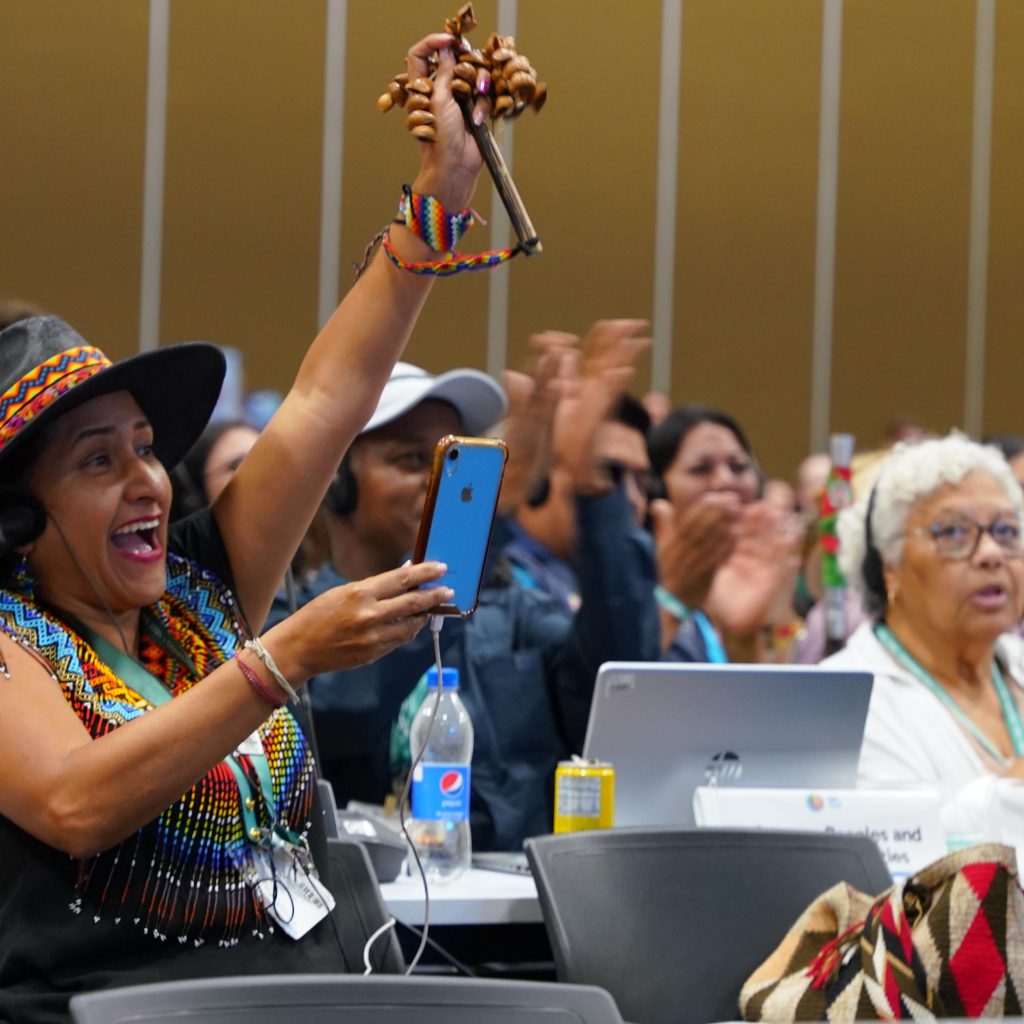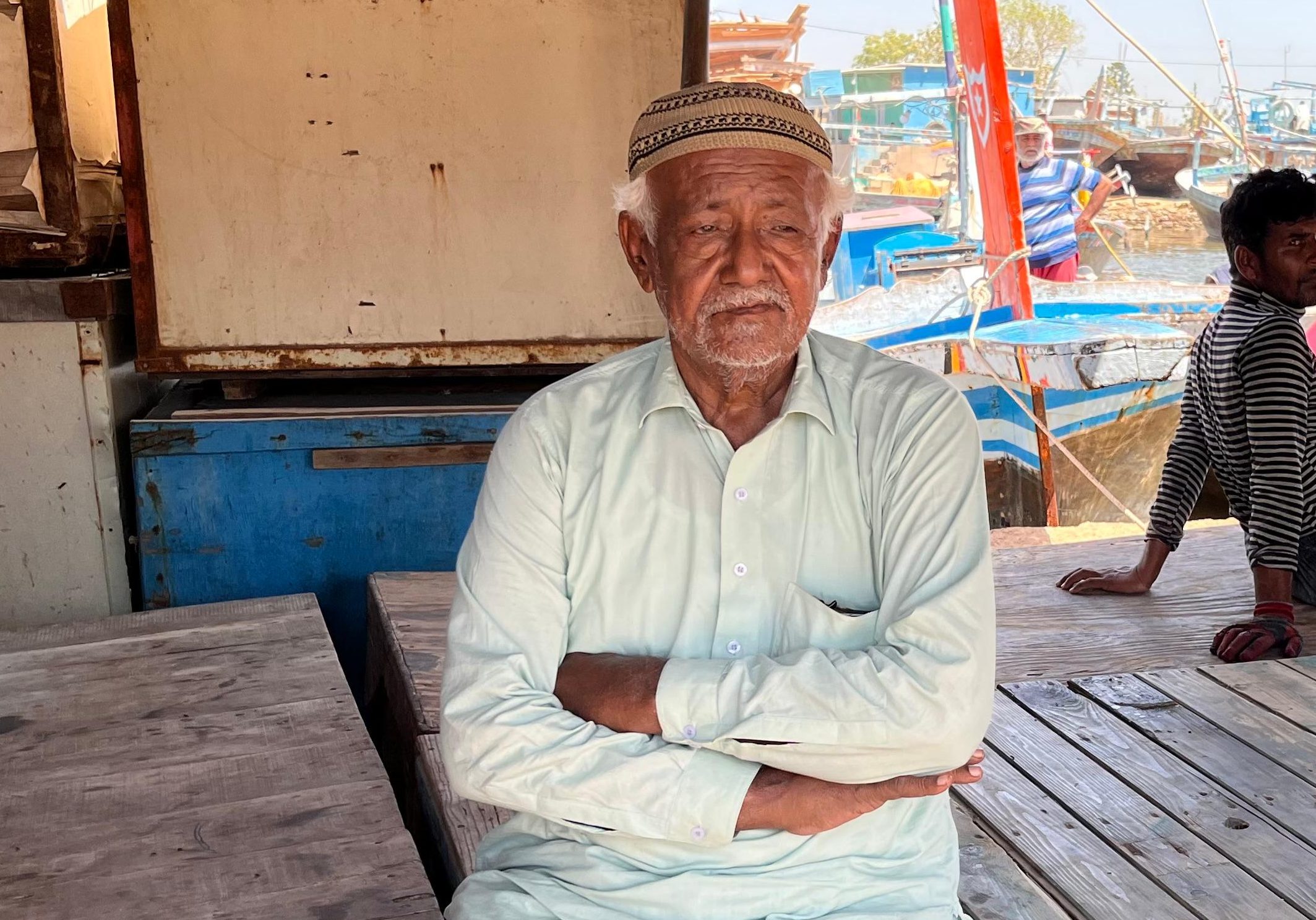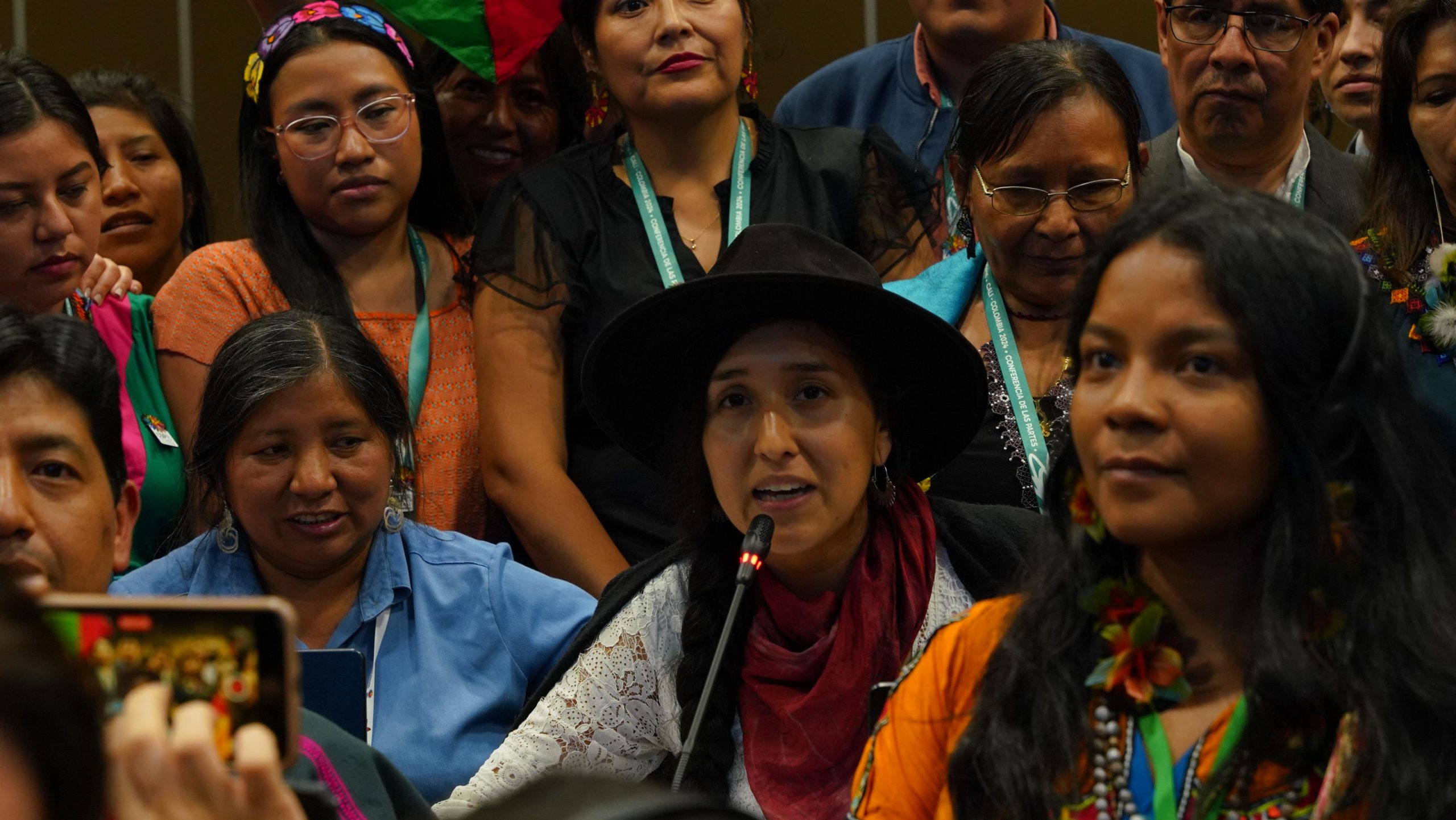At the COP16 hosted in Cali, Colombia, in November 2024, indigenous communities from across the globe were well represented. Especially those hailing from Latin America. They were colourful and noisy, attired in their traditional costumes, expressing themselves through gestures and ancestral languages.
Nearly every single day at the summit, an Indigenous caucus, either part of an international alliance or representing individual groups, held press conferences at the media centre in the Blue Zone of the COP16 summit. Their aim was to highlight their concerns about biodiversity protection, amplify their voices and ensure their perspectives were included in the negotiations directly impacting their ecologies.
“Indigenous people, who protect eighty per cent of the world’s biodiversity, are calling for respect for their rights – especially free, prior and informed consent. This means that no policy or project can proceed without the agreement of Indigenous Peoples and Local Communities,” said Osprey Orielle Lake of Women’s Earth and Climate Action Network, on Oct 22 at a press conference.
Indigenous people are “stewards of lands, ecosystems and communities”, she added, stressing that states cannot protect biodiversity without focusing on women’s leadership, local communities and affectees of the environmental destruction.

After two weeks of negotiations, by end November, the Indigenous Peoples and Local Communities (IPLCs) erupted into cheers and tears after United Nations Convention on Biological Diversity (CBD) delegates agreed to establish a subsidiary body that will include Indigenous peoples in future decisions on nature conservation, a development that builds on a growing movement to recognise the role of the descendants of some regions’ original inhabitants in protecting land and combating climate change[1].
Pakistan’s missing Indigenous voices
While Indigenous communities from Latin America and other regions made their voices heard at COP16, representatives from Pakistan’s indigenous communities were notably absent from this global platform.
For instance, the Pakistan Fisherfolk Forum, an alliance of indigenous fishermen. According to Abdul Majeed Motani, the forum’s former president, the fishing community has been residing alongside Sindh’s coastline for more than four centuries.

“Whenever there was development, we were forced to migrate,” he said, tracing the displacement of their community since the period of British rule over the Indian subcontinent from 1858 onwards when the colonialists began their large-scale infrastructure development. He described the destruction of their ancestral creeks and ocean, where he and his community fished, even enduring imprisonment in Indian jails for treading over Indian waters in search of sustenance. Those ancestral creeks and ocean are now filthy and smelly sewage dumps and devoid of marine life.
“There has been a genocide of indigenous fishermen in Karachi. Younger generations have abandoned the profession,” he added. He warned about the disappearance of their traditional fishing methods within a few years. When asked if his community was ever consulted on development projects impacting their livelihoods, he replied sharply, “Never. We were looted.”
The situation of Pakistan’s fishing communities depicts a broader international challenge that has been addressed in various conventions, particularly through Article 8(j) of the Convention on Biological Diversity.
International recognition of Indigenous rights
At the 1992 Earth Summit in Rio, 150 countries signed the Convention on Biological Diversity document which focuses on conserving various life forms on earth and ensuring equitable use of living resources.
The document contains 42 articles of which Article 8(j) is notable. It essentially requires countries to respect and protect traditional knowledge of Indigenous communities. It ensures when this knowledge is used, communities must give their approval and receive a fair share of benefits.
At COP3 in 1996, held in Buenos Aires, Argentina, countries agreed to organise a workshop to discuss the implementation of Article 8(j). During this event, two key proposals emerged:
- Creating a subsidiary body of the convention to advise on implementing Article 8(j) and its provisions.
- Developing a Programme of Work on Article 8(j) and its provisions as a guiding tool to achieve the commitments outlined in Article 8(j).
At COP4 in 1998, countries established a dedicated Working Group on Article 8(j). Finally, at COP5 in 2000, the Programme of Work on the Implementation of Article 8(j) and Related Provisions of the Convention on Biological Diversity was adopted through Decision V/16.
This historical development of Article 8(j) has established a framework that continues to evolve in its approach to Indigenous rights and knowledge protection.
How Article 8(j) works in practice
The Programme of Work on Article 8(j) has served as a primary mechanism for parties to achieve the commitments of Article 8(j), which are to respect, preserve, and maintain IPLCs’ knowledge, innovations and practices.
Its mandate is to promote fair and effective application of Article 8(j) with full and meaningful participation of the rightful holders of traditional knowledge.
The Article 8(j) working group develops guidelines and principles to help countries respect and appropriately use indigenous knowledge. These guidelines are voluntary as countries are not legally obligated to follow them.
It discusses and drafts recommendations concerning Indigenous Peoples’ knowledge and practices. These recommendations are forwarded as draft decisions to the convention’s governing body, the Conference of the Parties (COP), for approval and implementation.
The COP has recognised the International Indigenous Forum on Biodiversity, an indigenous caucus to the CBD, as a principal mechanism for Indigenous input into the Convention on Biological Diversity processes, including meetings and decisions.
Article 8(j) & Indigenous’ subsidiary body
In November 2024, at CBD COP16, Indigenous Peoples and Local Communities got a permanent body in the UN Convention on Biological Diversity after years of advocacy. This historic move makes the CBD the only UN environmental convention with a powerful platform for people to voice their demands and coordinate with state parties in defining criteria, actions, and programmes related to knowledge, innovations and practices associated with the convention.
Prior to this, Indigenous officials sought out delegates from various countries, often waiting for hours outside meeting rooms pleading for solidarity when issues impacting them came up for voting.
Known as the Subsidiary Body for Article 8(j), this new entity was adopted by 196 countries on the final day at COP16.
The operational model of the new subsidiary body, likely to be co-chaired by government representatives and indigenous and local communities, will be discussed further and adopted in the next COP summit scheduled for 2026 in Armenia.
Pakistan’s indigenous undefined in law
While this new subsidiary body represents significant progress globally, its potential benefit for Pakistan’s Indigenous communities remains uncertain due to their ambiguous legal status within the country.
Pakistan is the birthplace of one of the oldest Indus Valley Civilisations. Yet, none of its laws unambiguously recognise Indigenous people but allude to them as tribal or ethnic or religious minorities, according to Cultural Survival, an international Indigenous rights organisation with a global Indigenous leadership and consultative status with the Economic and Social Council.
Moreover, the 1973 Constitution of Pakistan does not explicitly recognise Indigenous peoples but instead categorises them along with ethnic, linguistic and religious minorities.
A few articles in the Constitution protect minorities’ rights and freedom. For example, Article 33 discourages parochial, ethnic, tribal, sectarian or provincial prejudices among citizens.
Article 36 talks about safeguarding the legitimate rights and interests of minorities, “including their due representation in federal and provincial services”.
Article 28 provides a broader perspective on the rights of IPLCs without explicitly naming them. It states, “any section of citizens having a distinct language, script or culture shall have the right to preserve and promote the same and subject to law, establish institutions for that purpose.”
This broad classification neglects the distinct identity of Indigenous communities, according to Dr Kashif Imran Zaidi, director of the School of Law and Policy at the University of Management and Technology, Lahore. In his research paper titled ‘Indigenous Peoples in Pakistan: In Consideration of the Right to Cultural Property and Identity’, he highlights this gap and the need for legal recognition of Indigenous communities.
Despite these constitutional limitations, Pakistan is signatory to several international agreements that could potentially provide stronger frameworks for Indigenous recognition which Dr Zaidi lists in his research paper.
Global treaties, potential for recognition
Such as the United Nations Declaration on the Rights of Indigenous Peoples and its following clauses:
Article 26(1): Indigenous peoples have the right to lands, territories and resources they have traditionally owned, occupied, used or acquired.
Article 26(2): They have the right to own, use, develop and control these lands based on traditional ownership, occupation or acquisition.
Article 26(3): States must legally recognise and protect these lands, respecting indigenous customs, traditions and land tenure systems.
Article 31(1): Indigenous peoples have the right to maintain, control, protect, and develop their cultural heritage, knowledge, and expressions, including sciences, technologies, genetic resources and intellectual property.
Article 31(2): States must take effective measures, in collaboration with indigenous peoples, to recognise and protect these rights.
Article 33: Indigenous peoples have the right to determine their identity or membership according to their customs, without affecting their right to state citizenship.
This treaty, however, is not a legal document that countries are strictly required to follow. Instead, it is more of a guideline.
The rights and freedoms it outlines — such as the right of Indigenous peoples to self-govern and not face discrimination — are already included in other international agreements that many countries including Pakistan are legally bound to follow.
Some of these rights and principles are part of what is called customary international law, which refers to widely accepted practices or rules that most countries agree on and follow over time, even if they aren’t written in a treaty.
Pakistan is also a signatory to the Indigenous and Tribal Peoples Convention, 1989 (No. 169), distinguishing tribal and Indigenous peoples, that includes the following stipulations:
Article 1(1a): Defines tribal peoples as those in independent countries who have distinct social, cultural and economic conditions and are governed by their customs, traditions or special laws.
Article 1(1b): Defines indigenous peoples as those descended from populations present before colonisation or state formation who maintain their own social, economic, cultural and political institutions.
Article 2: Self-identification is recognised as the fundamental criterion for determining indigenous or tribal status under the convention.
Challenges in defining Indigenous
Despite the existence of various conventions and declarations, there is no universally accepted definition of indigenous peoples. José Martínez Cobo, a PhD in Jurisprudence and Social Sciences, has proposed several criteria to help define them.
Such as historical continuity with pre-invasion and pre-colonial societies that developed in their territories, distinctiveness in culture, traditions, and identity and a position of non-dominance within the broader national society. Additionally, indigenous peoples are characterised by a strong determination to preserve, develop and transmit their cultural heritage to future generations.
Then, the UN agency World Intellectual Property Organisation (WIPO) focuses on Indigenous intellectual property issues, including traditional cultural expressions and genetic resources.
In 1998-99, WIPO launched a fact-finding mission called “Intellectual Property Needs and Expectations of Traditional Knowledge” to understand the concerns of Traditional Knowledge holders, including Indigenous peoples.
The findings offered valuable insights into their perspectives. In response, WIPO Member States, including Pakistan, set up the Intergovernmental Committee on Intellectual Property and Genetic Resources, Traditional Knowledge and Folklore (IGC) in 2000. Since 2010, the IGC has been working on legal frameworks to protect Indigenous traditional knowledge, cultural expressions and genetic resources.
International frameworks applicable to Pakistan
Even the Convention on Biological Diversity, which Pakistan is a signatory of, has also introduced two protocols related to genetic resources: the Cartagena Protocol and the Nagoya Protocol.
The Cartagena Protocol on Biosafety, adopted in 2000, is an international agreement that ensures the safe handling, transport and use of living-modified organisms derived from modern biotechnology, focusing on minimising risks to biodiversity and human health.
The Nagoya Protocol, adopted in 2014, aims to ensure the fair and equitable sharing of benefits arising from using genetic resources — such as plants, animals or microbes — in research or product development with the countries or communities providing these resources.
World wildlife trade regulator & Pakistan’s Indigenous
The Convention on International Trade in Endangered Species of Wild Fauna and Flora (CITES), is a global agreement to regulate the international trade of wildlife and plant species to prevent their overexploitation.
Adopted in 1973 and enacted in 1975, CITES requires member countries, including Pakistan, to implement national wildlife laws that align with its objectives.
CITES categorises species into three appendices, each with different levels of protection. At the COP10 in 1997, Resolution 10 was adopted, reinforcing the importance of involving local communities in wildlife conservation, particularly in the sustainable use of species such as elephants and other large mammals.
The conference resolution Conf. 10.14 aimed to benefit local communities by generating revenue through regulated hunting permits. This CITES convention paves the way for some recognition of Indigenous Peoples and Local Communities in Pakistan.
A senior official from the Federal Ministry of Climate Change told The Citizenry that due to the CITES agreement, local communities had been repeatedly mentioned in provincial wildlife laws, where wildlife community-based conservation (CBC) is mentioned.
He said the provincial wildlife acts included CBC programmes, and due to the CITES convention, they gave local communities some legal cover. In line with the wildlife acts concerning the community-based conservation programmes, he said, the local communities are around wildlife habitats on which they rely.
However, the CBC programmes, the official said, are mainly caprine conservation-based, comprising wild goats namely, markhors, Himalayan Ibex, Sindh Ibex, Sindh Urial, Punjab Urial and Afghan Urial. The custodians of these habitats are mostly considered local communities under the community-based conservation programme of the respective province’s wildlife act, added the ministry official.
These international obligations have influenced Pakistan’s provincial wildlife legislation, particularly in Sindh, where some provisions recognise the role of local communities in conservation.
Sindh Wildlife Act & local communities
For Pakistan’s Indigenous communities, the Sindh Wildlife Act offers limited recognition through community-based conservation programmes that are based on wild-goat species conservation, according to Javed Mehar, Sindh Wildlife Chief Conservator. Thus allowing local communities[2] living near wildlife[3] habitats to participate in protection efforts.
The most relevant aspects for Indigenous communities in the Sindh Wildlife Act include:
- Revenue sharing: When hunting licenses are issued for game reserves by the provincial government, eighty per cent of the proceeds from these licences goes to local communities while twenty per cent is retained by the government.
- Protected area designations: Under the Sindh Wildlife Protection, Preservation, Conservation, and Management Act, 2020, there are types of protected areas[4] (national parks[5], wildlife sanctuaries[6] and game reserves[7]) where local communities serve as unofficial custodians. However, Sindh has only one national park – Kirthar National Park – covering 308,733 acres across Karachi and Dadu. In addition, the province is home to 34 wildlife sanctuaries and 13 game reserves distributed across various districts.
- Prohibited activities: The Act restricts activities in protected areas that could harm the ecosystems important to indigenous communities including draining, poisoning or diverting water sources, cutting, burning or collecting plants or trees and mineral extraction, though exceptions can be made for scientific research, enhancing scenic beauty and public interest projects.
While these provisions recognise the connection of local communities to their lands, they fall short of acknowledging specific Indigenous rights to habitats or ancestral knowledge. The focus primarily remains on management of wildlife rather than in-depth protection of the Indigenous way of life.
Ground reality: implementation gaps
Despite these legal frameworks and provisions, the gap between legislative intent and on the ground implementation remains a significant challenge for Pakistan’s Indigenous communities. The communities continue to face displacement and loss of their traditional livelihoods. The new subsidiary body established at COP16 presents an opportunity but one that requires Pakistan to first recognise and legally define its Indigenous populations.
For local communities like the fishermen of Sindh’s coast, international developments will remain distant unless domestic laws progress to specifically recognise their status and rights. Without these basics, Pakistan’s Indigenous voices will continue to be absent from global platforms where decisions affecting them are made.
The way forward for Pakistan is to bridge this gap and to recognise that these are essential building blocks of sustainable biodiversity conservation.
- [1] Source: https://www.msn.com/en-ca/news/canada/delegates-agree-to-establish-indigenous-subsidiary-body-at-cop16-biodiversity-summit-in-colombia/ar-AA1tngca?apiversion=v2&noservercache=1&domshim=1&renderwebcomponents=1&wcseo=1&batchservertelemetry=1&noservertelemetry=1
- [2] The Sindh Wildlife Act defines a community as “managing or is involved in management of any other type of conservation area”.
- [3] The Sindh Wildlife Act defines wildlife to include organic resources, animals, birds, fish, reptiles, vegetation, soil and water
- [4] According to Sindh Wildlife Act, Section (8), provincial wildlife department can “declare any state land, wasteland, reserved or protected forest as a whole or portion thereof, as a protected area”.
- [5] The Sindh Wildlife Act defines a National Park as a natural area to be protected and notified under the Act to maintain the ecological, biological and or cultural significance and integrity for present and future generations.
- [6] The Sindh Wildlife Act defines a “sanctuary as an area of land or coast owned or managed by the government for the protection of wildlife, especially for their undisturbed breeding or staging and wintering of migratory waterfowl”.
- [7] The Sindh Wildlife Act defines game reserves as “an area managed by the government for hunting and shooting during hunting season”.
Header image by UN CBD
Subedited by Maleeha Hamid Siddiqui
This story was produced as part of the 2024 CBD COP16 Fellowship organized by Internews’ Earth Journalism Network.



